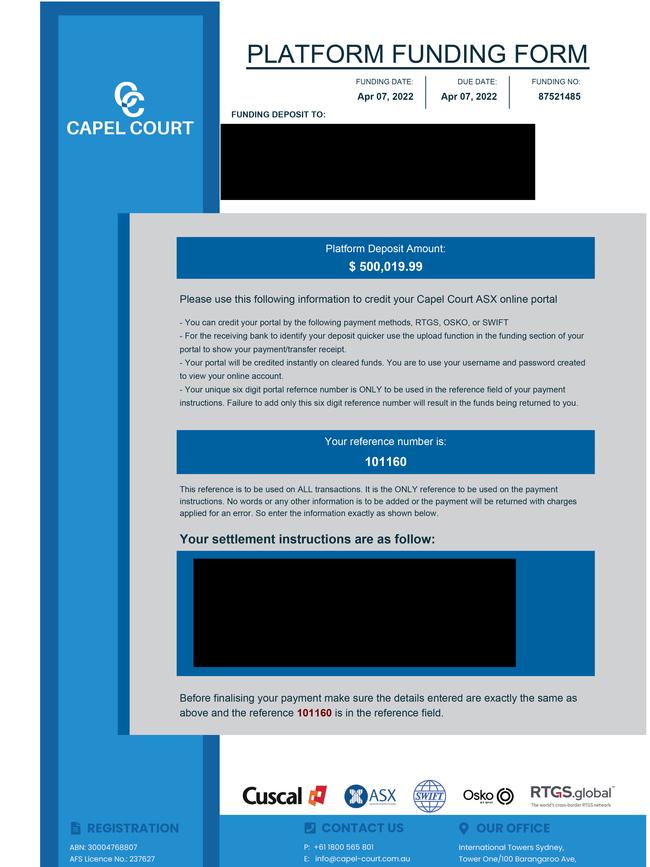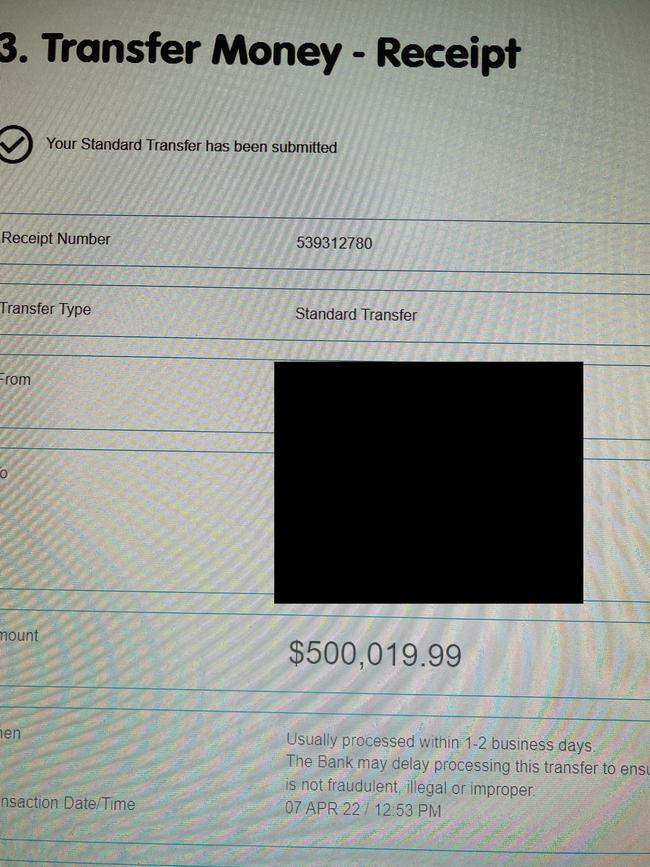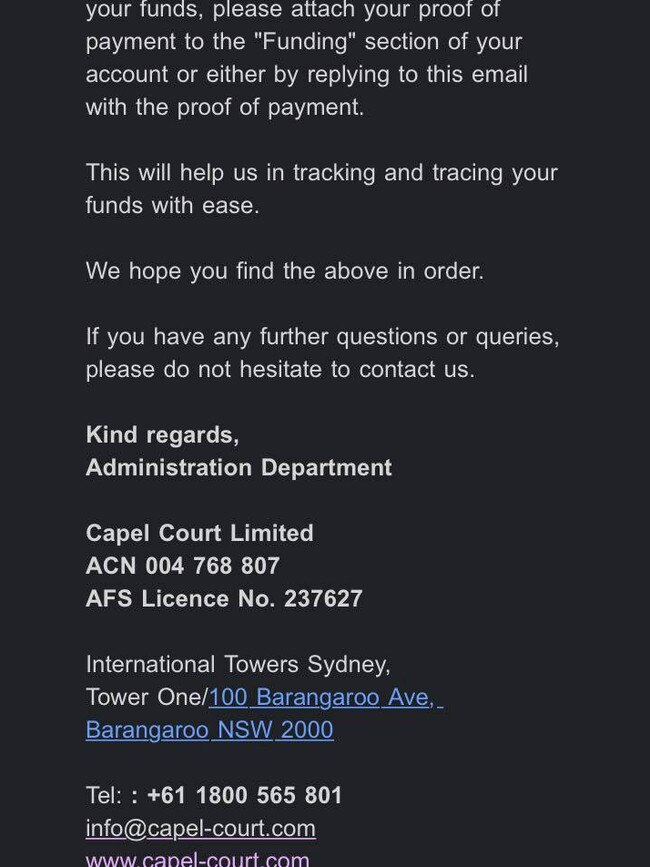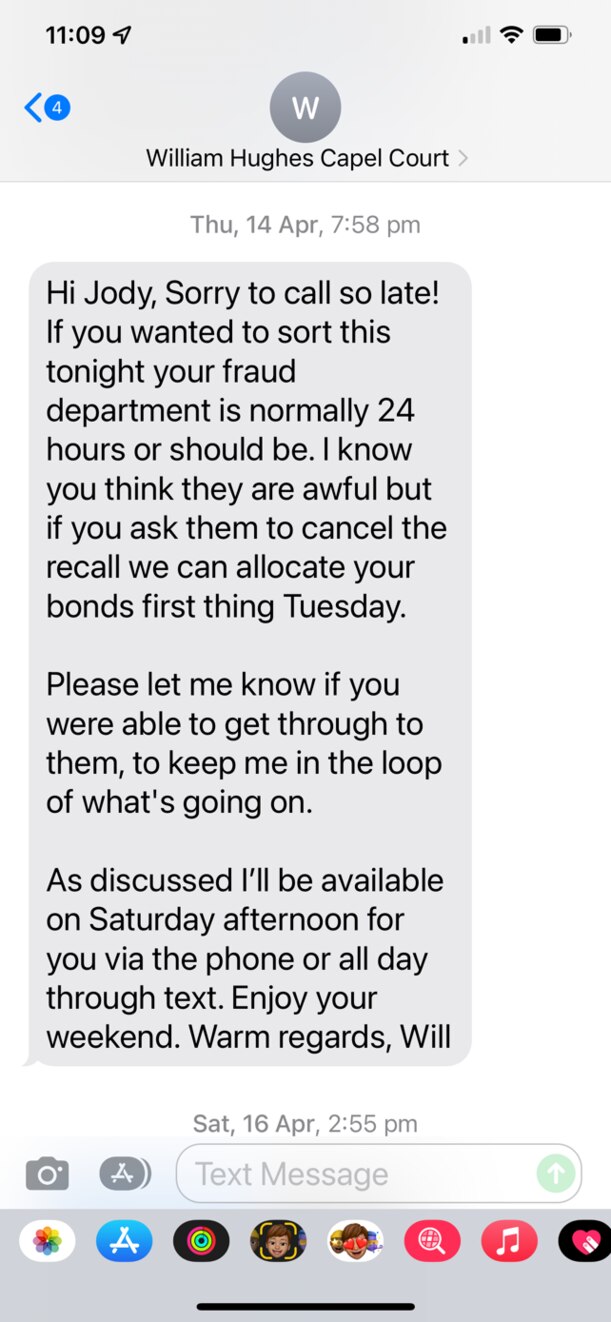NSW teacher loses $500k to elaborate scam two months in the making
Jody Bridges worked for years to scrape together money to set her family up for life – but her big plans came crashing down in one text message.
Business
Don't miss out on the headlines from Business. Followed categories will be added to My News.
A family from NSW has been left reeling after scammers stole an eye-watering $500,000 from them and then sent them death threats.
Jody Bridges and her husband Corey have been working hard all their lives as a maths teacher and landscaper respectively, sometimes juggling five jobs at once, and thought it had finally paid off.
They sold a Sydney property they’d been holding onto for a long time during the Covid-inspired housing boom, walking away with $1 million in profit.
It was their one chance to get ahead and Ms Bridges heard from a friend that putting money in government bonds was a safe investment strategy.
She found a website offering bonds affiliated with ANZ called Capel Court with an Australian Business Number that she even double-checked the authenticity of with ASIC.
For two months she went back and forth with representatives from the company, asking questions, filling in forms, being provided with bank statements and even creating a login for the very sophisticated website portal.
Ms Bridges, 42, finally transferred her money over in two instalments of $500,000 last month. But on the second transfer, her bank warned her it was a scam. By then, half a million dollars had already gone through where it is understood to have been converted into untraceable bitcoin.
“This could happen to anybody,” the distraught mum-of-three told news.com.au. “Pretty sure I’m almost f**king bankrupt.”
Want a streaming service dedicated to news? Flash lets you stream 25+ news channels in 1 place. New to Flash? Try 1 month free. Offer ends 31 October, 2022 >



Ms Bridges is very “savvy” with her money and has made a number of good financial decisions for her family – which netted them the $1 million from a successful home sale.
Everything about the scam felt very professional, including the fact that she first came across the fake Capel Court website on February 23.
It took two months to part her from her funds as there was no rush from the scammers to send through the money, which would have immediately raised her suspicions.
“No one forced me or pressured me,” she said.
One time it took her four weeks to reply to an email and nobody ever sent her a follow-up to chase her up.
“I checked everything, ASIC said it was a legitimate company,” she explained.
The problem is there really is a Capel Court bonds company that ANZ owns – but this wasn’t it. The scammers had stolen the company’s credentials and pretended to be them.
She tried to transfer her money over in $500,000 instalments on April 7 and 9 but the money bounced back.
Then on April 13 and 14, the scammers helped her send through her money through a tele-transfer of $500,000 each, with the first one going through but the second one being blocked by her bank, the Teachers Mutual Bank.
She’s been fighting to get her money back ever since.
Have a similar story? Get in touch | alex.turner-cohen@news.com.au


“When I found out it was a scam it was gut wrenching,” Ms Bridges said.
“I would never ever forgive myself … the guilt I have to live with. I could never work enough to ever repay that.”
“I didn’t come from a lot, I feel my job in life is to set my kids up, to be the best mum I can and to set my kids up for life. My mum struggled.
“We just worked our butts off, we put our heads down and thought now’s the time to set up our future.”
Ms Bridges was provided with the mobile and office phone numbers of two so-called bank employees who both had broad Aussie accents and used the names William Hughes and Eugene Grey.


Even with the Teacher’s Mutual Bank adamant that these people were scammers, she still wasn’t fully convinced – especially as the fraudsters continued to contact her even after the money had been taken.
In hindsight, it appears that they kept in touch because they were trying to take her remaining $500,000 by convincing her to remove the recall the bank had placed on her final transaction.
Her main point of contact, a man masquerading as William Hughes, assured her the money was safe in a bizarre text message.
He also tried to get her to lift the recall on the other $500,000, which the bank had blocked because it thought the activity was suspicious.
When she finally realised they were scammers, she called them back and they turned nasty, swearing at her.
Eugene Grey said he would return $400,000 of her own money if she paid him a further $100,000.
When she refused, he threatened her family, telling her the name of her oldest child and saying he knew where she lived.
When news.com.au tried to call these numbers, Mr Hughes had disconnected his phone and Eugene Grey hung up straight away.


Ms Bridges was instructed to transfer the money into an ANZ account belonging to another man.
It’s understood that person then moved all her funds into cryptocurrency exchange Binance.
The money has since left Binance, news.com.au understands.
The bank account was frozen after the bank raised the alarm.
Ms Bridges said the man then rang her angrily trying to get her to remove the recall on the funds, and to unfreeze the account.
News.com.au has contacted the person for comment.
NSW Police would not confirm to news.com.au whether the man was a person of interest in their investigations into Ms Bridges’ missing money.

Now more than a month since the transfer, Ms Bridges is no closer to getting her money back.
She has lodged reports with NSW Police and the Australian Financial Complaints Authority (AFCA) about how Teachers Mutual Bank allowed for one transaction to go through and not the other.
“Teachers Mutual Bank didn’t ask any questions, it should be out of the ordinary,” she said.
“They were adamant that it was a scam. Why didn’t you [the bank] pick up the other three transfers then?”


This isn’t the first time Australian-based scammers have made off with a whopping sum of money by pretending very convincingly to be a bank.
Earlier this month, news.com.au reported on a Melbourne widow who lost $760,000 from the life insurance payout of her husband in an elaborate Macquarie Bank term deposit website that turned out to be fake.
In fact, they could be the same group of scammers.
The Melbourne woman tracked down her funds and discovered they had been channelled through instant payment systems called Cuscal and Money Tech.
For Ms Bridges, the initial two payment methods the scammers wanted her to use – which both bounced back – were these same platforms.
Companies respond
In a statement, ANZ said: “We are aware of this latest bond scam, which is a particularly sophisticated operation that has unfortunately defrauded some people of their money.
“ANZ is assisting NSW Police with its ongoing investigations into the matter and we are working through any useful information that may help.”
The Teachers Mutual Bank said in a statement to news.com.au: “Teachers Mutual Bank Limited takes investment scams very seriously. We work to help keep our members safe from scams and financial loss.
“As this matter is presently before AFCA, we will continue to follow the AFCA complaints resolution process and adhere to our Privacy obligations to our members while this is under investigation.
“Teachers Mutual Bank Limited has been in ongoing communication with the impacted members.”
In a statement to news.com.au, Binance said they “have been made aware of the circumstances” surrounding Ms Bridges.
“As a result of this we are conducting our own internal due diligence via a dedicated team. Binance is committed to complying with AML/CTF regulations and working collaboratively with law enforcement.”
alex.turner-cohen@news.com.au
Originally published as NSW teacher loses $500k to elaborate scam two months in the making





